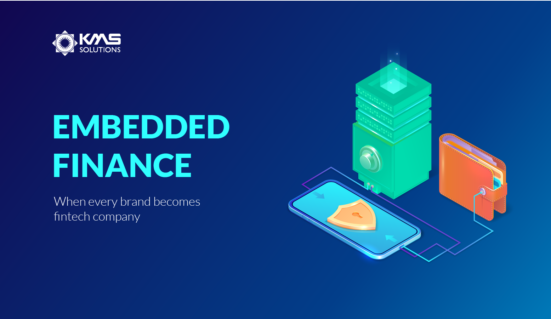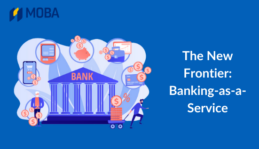Embedded finance is when a brand becomes a fintech company. With embedded finance, companies of all types can make financial services available to customers precisely when and where they need them. Leading companies such as Uber, Amazon, Apple, or Samsung have already embraced embedded finance by integrating bank accounts, payments, even lending services into their ecosystem.
What is Embedded Finance?
Embedded Finance, is the integration of financial products into the services of non-financial or non-bank companies. In other words, it describes the way financial services are applied and leveraged by companies not originating from the financial sector.
The emergence of embedded finance makes sense from an economic standpoint: companies that “embed” financial services into their products can enrich their offerings and be able to enter new markets.
For example, an eCommerce company (Shopee) or a ride-hailing app (such as Grab or Uber) can integrate payment services into their existing shopping platform.
Before there is embedded finance, if a non-bank company were to provide financial products, it had to build a Fintech subsidiary. This comes with huge expenses and takes dozens of months to complete – even more to have profits. Embedded Finance is cheaper (thanks to low or no capital expenditure) and faster (it takes only a couple of weeks to implement).
Embedded finance is also better for customers. It “embeds” your non-financial platforms with true fintech experiences that feel the most intuitive and convenient to customers.
Use cases of Embedded Finance
There are numerous embedded finance use cases that a non-financial company can adopt.
Buy Now Pay Later: Buy Now Buy Later is now used more widespread by modern shoppers thanks to its convenience. It’s a type of credit for online products that allows purchasers to pay it off over time. With BNPL as embedded finance, companies can empower themselves to shop differently.
Point-of-service lending: As another form of Buy Now Pay Later, POS lending lets customers purchase goods and pay for them over time. A business can embed POS lending when it wants to provide larger and significant loans. Because of the high volume of POS loans, its providers will need to require customers to provide additional credit data to ensure that they can repay.
Integrated insurance services: Sometimes, customers want merchants to compensate should anything happen to their goods (such as a car or an expensive bike). This is where integrated insurance comes in. For example, Tesla offers auto insurance at their Point of Sale.
Investments and trading: In investment apps or platforms, an embedded finance tool enables customers to connect with traditional banks to invest and trade stocks.
Fintech-as-a-service: this form of embedded finance offers a wide array of financial features, from customer acquisition to invoicing.
Why do today’s businesses need embedded finance?
Because all companies will become fintech companies.
Embedded Finance evolved from Digital Lending and Decentralized Finance (where financial services are provided without intermediaries). With technologies growing so fast, embedded finance can expand as broad as the financial service sector. Because embedded finance can be deployed in any segment that involves selling & buying, it can become even broader than the financial sector itself
Already, embedded finance is expanding the size and value of the finance & banking industry by increasing exponentially credit and other use cases as we discussed above. It is predicted that embedded finance will value $7 trillion dollars in less than 10 years.
It’s easy to see that Finance is now embedded into every biggest company’s IT stack and business model. For example, ride-hailing apps (Grab or Uber), e-Commerce sites (Shopee or Tiki), and investment apps (Binance) have fully embraced embedded finance in the forms of integrated online payments.
As an invention focusing on user experience, embedded finance lets customers use financial services wherever and whenever they want without making their shopping journey any more complex.
Embedded finance brings benefits to both the company providing it and the customers using it.
Winning with embedded finance
Embedded finance can bring benefits to all fronts: either it’s the digital platforms, the traditional financial institutions, or the customers—in other words, a win-win-win investment
Benefits for the digital platforms
Improved Customer Lifetime Value (CLTV), new sources of revenue, increase in customer activation, improved competitive advantage, more valuable data are some benefits that embedded finance can bring to a digital platform.
Improve Customer Lifetime Value (CLTV) and other key business metrics
Embedded finance provides in-context credit that nudges customers to decide to make purchases or even purchase more. In turn, it improves Average Order Value (AOV), customer retention, and Customer Lifetime Value (CLTV).
Unlocks additional sources of revenue
Embedded finance can enable a new revenue share for the digital platforms with very low or no financial liability
Increase in customer activation
By adding more lines and types of credit, embedded finance facilitates merchant acquisition as it makes the platform’s value proposition more attractive.
Stand out from competitors
By adding new use cases to the product, embedded finance scales its offerings vertically
Get valuable data
Embedded finance unlocks valuable data on user behavior, which can be used to enable personalized sales and marketing.
Benefits for Financial Institutions
Some may think that embedded finance can threaten financial institutions’ profitability. It depends. If banks offer relevant embedded finance products, they have an equal chance of success as fintech companies.
Access to new and larger pools of customers
With embedded finance, financial institutions can leverage their established customer base to access diverse borrower pools with built-in decision-making intelligence that optimizes profitability and portfolio health.
Build a more profitable business
With embedded finance, a financial institution can increase margins and reduce costs for end customers through enhanced underwriting and credit life cycle management.
Benefit for users
At the end of the day, embedded finance is all about customers and their convenience when paying for goods.
Increased access to affordable financial services
Embedded finance enables access to flexible financial services on user-friendly terms
Customized offerings
Embedded finance providers can tailor financial solutions to fit customers’ preferences and behaviors.
Improved customer experience
Embedded finance improves customer experience through in-context financial offerings
Examples of Embedded finance: how embedded finance is used across industries
Until now, embedded finance has been applied across all industries, either its automotive, e-commerce, ride-hailing, or even coffeehouse chain … In what follows, let’s discuss how Tesla, Uber, Starbuck, and Stripe are leverage embedded finance
Tesla
In 2019, this electric car company introduced its own auto insurance for some car models. Tesla is able to offer affordable insurance packages because it leverages its own technology, safety, and serviceability of its cars. Tesla can use the data from this embedded insurance to evaluate customers’ risk profiles.
Tesla’s embedded insurance is offered at the Point-of-Sale online or right at the time of purchase at showrooms. Tesla is a classic example of Embedded Finance adopted by non-financial companies to improve and build long-term revenue-stream.
Uber
Uber offers dozens of payment methods through integrations. The ride fee is automatically calculated and charged to the payment method that users prefer.
By introducing payments that work seamlessly inside its app, Uber removed the friction from payments and improved customer retention.
Starbucks
Starbucks has developed its own wallet solution to leverage its loyal customer base. Through its mobile apps and gift cards, customers can load money from their bank account, pay online in advance before collecting the order from a store, and earn rewards.
This way, all the money customers add to the cards and the app gives easy cash flows to Starbucks. The company has also made $155 million from unredeemed cash balances. It reinvests this back into the business and other expansion opportunities. As a result, Starbucks has managed to make money from its customers at a negative 10% interest rate.
Stripe
Stripe Treasury’s Banking-as-a-Service API allows businesses to embed financial services into their platform. It allows merchants to directly get a Shopify-enabled bank account to use their funds. The feature – powered by Stripe Treasury in the background – allows merchants to obtain a variety of financial products and oversee their finances, all within Shopify.
Getting started with embedded finance
There are two ways a company can adopt embedded finance and make it integral to their user experience.
Build – using your company’s talent and resources to build embedded finance in-house
In theory, building one’s own finance stack seems to provide more advantages as home-grown embedded finance products can enable contextual use cases. But in reality the build approach can be complex, time-consuming, and its outcomes are uncertain.
It can take a team of at least 10 people to develop a new product. This team must build or purchase new systems, integrate 3rd-party models, develop, test, and deploy the feature. It requires a hefty upfront investment and involves complex processes.
Depending on the type of the offering, developing embedded finance in-house could require partnering with a regulated payments processor, a secure payment gateway, seeking required licenses and more. In doing this, the company may be distracted from its core services while facing delays and cost overruns due to the project’s uncertainties.
The costs don’t end once set-up is complete. Maintenance is an ongoing and expensive process. In fact, 70% of the development costs occur after implementation.
Thus, building an embedded finance solution is suitable for only large organizations with extra resources and talent to spare with a desire to own the entire stack.
Partner – collaborate with an embedded finance infrastructure company to leverage their expertise
Partnering with a specialist embedded finance provider is a cost-efficient way for companies to leverage digital innovation with the help of domain expertise that comes with the partnership. This approach reduces substantially the time to market.
When it comes to capital, a company offering credit will probably deploy its own cash reserves to underwrite loans – money that could have been invested in other parts of the business.
With a lender in place as part of the Embedded finance solution, the infrastructure costs are split across multiple partners, making it a cost-effective proposition for businesses. Maintenance and upgrades are also taken care of by the third-party embedded infrastructure provider.
Conclusion
Embedded Finance services are expected to generate $140.8 billion of revenue by 2025. Embedded finance is transforming the way in which consumers navigate financial services. It allows companies across sectors to integrate financial products into their platforms with the ultimate gold to augment their business, create new revenue streams, and enhance customer lifetime value (CLTV).







